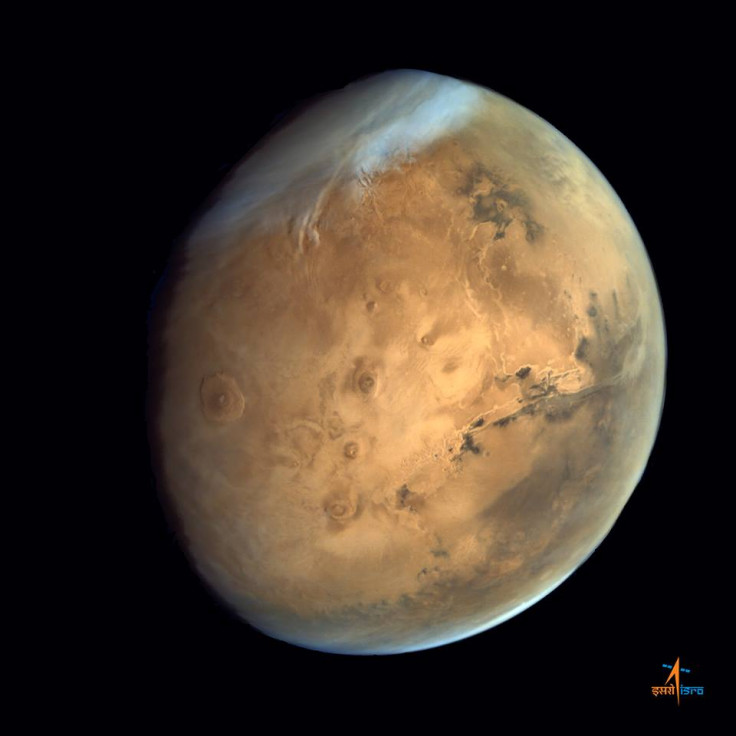Space 2014: India takes giant leaps with low-cost indigenous Mars mission

In a first, Europe landed a probe from 22 kilometres above comet 67P Churyumov hurtling towards the inner solar system at 18 km a second.
Nasa's Orion unmanned test flight cleared the Earth's atmosphere and headed 5,794 km into deep space, orbiting the Earth twice before returning.
And India's space agency Isro successfully placed a low-cost probe in Mars' orbit in a first attempt this year.
The feat, achieved on 24 September saw India's space agency Isro place its indigenous Mars Orbiter Mission probe in an elliptical orbit around the Red Planet, from where it has been taking full disc pictures of the planet and conducting experiments using five instruments on board.
'Nobody gets Mars right on the first try', said Time magazine, in placing 'supersmart spacecraft' MOM among the top 25 inventions of the year.
India joined the exclusive club of global space powers, being the fourth only after the US, Russia and EU to place a satellite in the orbit around Mars.
Roughly, half of all space spacecraft sent to Mars have crashed or gone off course.
Launched on 5 November, 2013, from India's spaceport at the Satish Dhawan Space Centre, Sriharikota, the 1350 kg Mars Orbiter Mission (MOM) was designed primarily as a technology demonstration experiment to check the nation's capabilities in space missions.
The secondary objective was a six-month-long science mission to study the Martian atmosphere and surface mineralogy. If the fuel lasts, and MOM does not go into a longer Mars eclipse, the spacecraft could work for 10 months.
According to the space agency, the orbiter now has almost 40 kg of fuel left and can operate for a few years. The electronics on board have a lifespan of over 15 years.
Low cost, short notice
Approved in late 2012 and put together in 15 months, MOM cost a little around £45m ($70m), compared to the £120m Nasa spent on Maven. (Maven carries nine instruments and a mission life of over a year.)
The low cost project relied on made-at-home rocket launchers and a launch window that allowed for the least fuel to be used up on the 700 million km journey.
MOM has braved the flyby of Comet Siding Spring, after it was parked along with Nasa's Maven and Mars orbiter, and Europe's Mars Express on the far side to avoid damage.
The text-book orbit insertion saw the reorientation of the spacecraft to align it for velocity reduction, following which, the main liquid apogee engine was fired after it spent months in slumber.
Tense moments followed as the speed of the space craft was lowered to allow the planet's gravity to capture it into its orbit.
The execution of commands was all done when the probe was within a small circle of less than two km.
Unmanned crew module
The next milestone for the Indian space ambition followed soon with the successful launch of its heaviest rocket GSLV-Mk III, which carried the LVM3-X/CARE suborbital mission, being tested for atmospheric reentry by an unmanned crew module.
With the recovery of the Care module from the Bay of Bengal, the stage has been set for manned spaceflight programmes.
The rocket enhances India's capability in the multi-million dollar commercial launch market.
The 630.5-tonne rocket GSLV Mk III makes India self-reliant in launching heavier communication satellites which weigh 4,500 to 5,000 kg.
Global recognition followed the space milestones achieved.
Joint missions
Nasa signed a pact with Isro to work together on an Earth observing satellite mission and study possible joint missions to Mars.
The Nasa-Isro Mars Working Group will investigate enhanced cooperation between the two countries in Mars' exploration.
A joint Nasa-Isro Synthetic Aperture Radar (NISAR) mission, targetted to be launched in 2020 will make global measurements of land surface changes to improve understanding of climate change impacts.
The year also saw the launch of GSLV-D5, the eighth flight of India's Geosynchronous Satellite Launch Vehicle (GSLV) with a third Indigenous Cryogenic Stage.
GSAT-16, an advanced communication satellite, configured to carry a total of 48 communication transponders, the largest for Isro, was also launched. The IRNSS-1C which is the third in the Indian Regional Navigational Satellite System (IRNSS) series of satellites was launched by PSLV C26.
Besides thinking of a satellite to study the sun and space mission vehicle to carry astronauts in near Earth orbit for a few days, Isro plans to set up an astronaut training centre in Bengaluru. The agency is equally keen to address some of the growing needs for connectivity, broadband internet and rural connectivity using advanced communication and navigation satellites.

© Copyright IBTimes 2024. All rights reserved.





